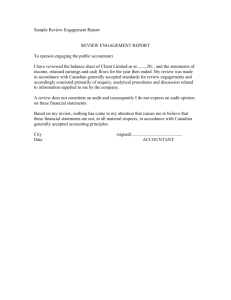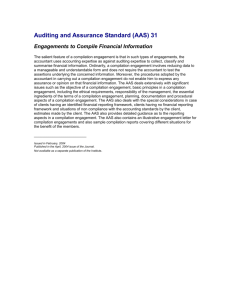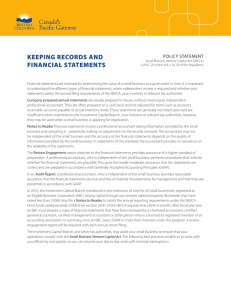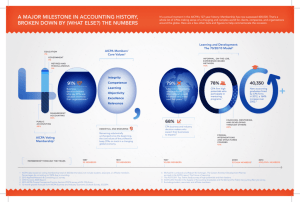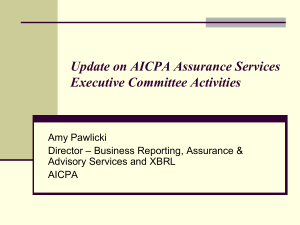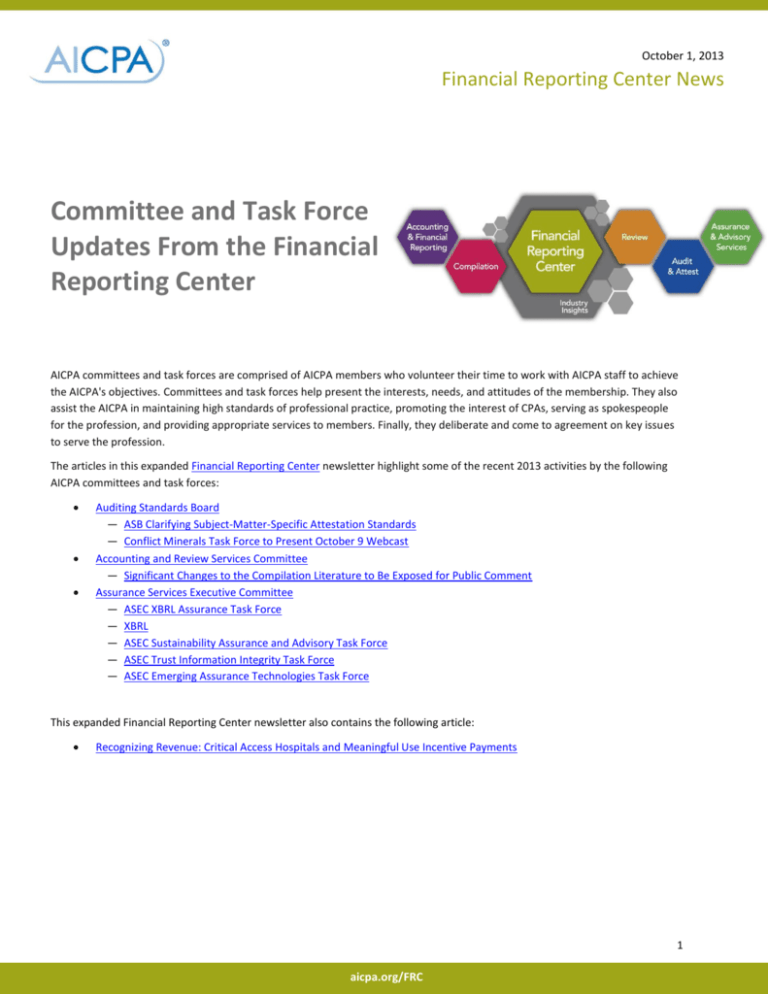
October 1, 2013
Financial Reporting Center News
Committee and Task Force
Updates From the Financial
Reporting Center
AICPA committees and task forces are comprised of AICPA members who volunteer their time to work with AICPA staff to achieve
the AICPA's objectives. Committees and task forces help present the interests, needs, and attitudes of the membership. They also
assist the AICPA in maintaining high standards of professional practice, promoting the interest of CPAs, serving as spokespeople
for the profession, and providing appropriate services to members. Finally, they deliberate and come to agreement on key issues
to serve the profession.
The articles in this expanded Financial Reporting Center newsletter highlight some of the recent 2013 activities by the following
AICPA committees and task forces:
Auditing Standards Board
— ASB Clarifying Subject-Matter-Specific Attestation Standards
— Conflict Minerals Task Force to Present October 9 Webcast
Accounting and Review Services Committee
— Significant Changes to the Compilation Literature to Be Exposed for Public Comment
Assurance Services Executive Committee
— ASEC XBRL Assurance Task Force
— XBRL
— ASEC Sustainability Assurance and Advisory Task Force
— ASEC Trust Information Integrity Task Force
— ASEC Emerging Assurance Technologies Task Force
This expanded Financial Reporting Center newsletter also contains the following article:
Recognizing Revenue: Critical Access Hospitals and Meaningful Use Incentive Payments
1
aicpa.org/FRC
Auditing Standards Board
The Auditing Standards Board (ASB) is the AICPA’s senior committee for auditing, attestation, and quality control applicable to the
performance and issuance of audit and attestation reports for nonissuers. Its mission is to develop and communicate
comprehensive performance, reporting, and quality control standards and practice guidance to enable auditors of nonissuers to
provide high quality, objective audit and attestation services at a reasonable cost and in the best interests of the profession and
the beneficiaries of those services, with the ultimate purpose of serving the public interest by improving existing and enabling new
audit and attestation services.
ASB Clarifying Subject-Matter-Specific Attestation Standards
In July 2013, the ASB issued an exposure draft of a proposed Statement on Standards for Attestation Engagements (SSAE)
Attestation Standards: Clarification and Recodification that clarifies the “general” attestation standards and provides a framework
for performing examination, review, and agreed-upon procedures engagements. The objectives of the clarity project are to make
the professional standards issued by the ASB easier to read, understand, and apply through the use of certain drafting
conventions, and also to converge the ASB’s standards with those of the International Auditing and Assurance Standards Board
(IAASB). (See the article “Exposure Draft to Clarify the “General Attestation Standards” Coming Soon” in the July 2013 Financial
Reporting Center Quarterly Update for more detailed information about the attestation clarity project.)
With the completion of an exposure draft that addresses the general attestation standards, the ASB has been clarifying the
subject-matter-specific attestation standards that build on the general attestation standards to create subject-matter-specific
engagements (for example, an examination of internal control over financial reporting or a review of pro forma financial
information). The six extant subject-matter-specific attestation standards (AT sections 301–801 [AICPA, Professional Standards])
address the following topics: prospective financial information, pro forma financial information, internal control over financial
reporting, compliance with laws and regulations, management’s discussion and analysis, and controls at service organizations.
Because it is so closely related to an audit of financial statements, at its July 2013 meeting, the ASB proposed redrafting AT section
501, An Examination of an Entity’s Internal Control Over Financial Reporting That is Integrated With an Audit of Its Financial
Statements, as an auditing standard with the intention of moving it out of the attestation standards. At its October 15–17, 2013,
meeting, the ASB will discuss issues related to such a proposal; for example, how it might affect the other auditing standards. The
ASB also expects to vote to expose for comment a draft of clarified AT section 301, Financial Forecasts and Projections; AT section
401, Reporting on Pro Forma Financial Information; and AT section 601, Compliance Attestation.
Conflict Minerals Task Force to Present October 9 Webcast
The Conflict Minerals Task Force of the ASB will be presenting a webcast about its work with the SEC to address issues related to
the Independent Private Sector Audit (IPSA) of an issuer’s Conflict Minerals Report (CMR), required as a result of the Dodd-Frank
Act. These issues include the objective of the audit and the description of the design of the issuer’s due diligence framework in the
CMR, for which the SEC is expected to address by issuing FAQs in the near future. The task force will also discuss other issues that
it has been addressing, including suitable criteria for performing the IPSA as an attestation engagement, what evaluations are
outside the scope of an IPSA, and appropriate examination procedures for an IPSA. Register today for the October 9 webcast at 3
p.m. ET. Refer to the AICPA Conflict Minerals Resources page for guidance related to issues of auditor independence.
Accounting and Review Services Committee
The Accounting and Review Services Committee (ARSC) is the AICPA’s senior committee for compilations or reviews and is
designated to issue pronouncements in connection with the unaudited financial statements or other unaudited financial
information of nonpublic entities. Its mission is to develop and communicate comprehensive performance and reporting
standards and practice guidance to enable accountants of nonissuers to provide high quality, objective compilation and review
services in the best interests of the profession and the users of compiled and reviewed financial statements, with the ultimate
purpose of serving the public interest.
2
aicpa.org/FRC
Significant Changes to the Compilation Literature to Be Exposed for Public Comment
This fall, ARSC will expose for public comment three proposed standards that, if passed as final standards, would significantly
affect the literature for compilation engagements. The proposed standards, written in clarity format, will have a comment
deadline in early May 2014.
The proposed standards are as follows:
A proposed revised compilation standard that would provide requirements and guidance to an accountant when
engaged to perform a compilation engagement on historical financial statements.
A new standard that would provide requirements and guidance when an accountant is engaged to prepare financial
statements for a client but has not been engaged to perform a compilation, review, or audit with respect to those
financial statements.
A new standard that would provide requirements and guidance when an accountant agrees to permit the use of his or
her name in a report, document, or written communication that also includes financial statements with respect to which
the accountant did not issue a compilation, review, or audit report. The accountant may or may not have prepared the
financial statements.
The proposed revised compilation standard would modify the applicability of the compilation literature. Currently, AR section 80,
Compilation of Financial Statements (AICPA, Professional Standards), applies when an accountant is engaged to report on
compiled financial statements or submits financial statements to the client or to third parties. Submission is defined as “prepares
and presents.” Whereas submission worked well as a trigger for the compilation service when SSARS No. 1 was issued in
December 1978, cloud computing and other applications have made it difficult to determine who (or what) has prepared the
financial statements.
For example, take a situation where an accountant performs bookkeeping services for a client. Perhaps the accountant has access
to the client’s cloud computing system and makes a few journal entries to record payroll tax payments, sales tax payments, and
depreciation expenses for a given period. The company’s internal bookkeeper records certain recurring expenses such as utilities
and office expenses. At the end of each month, the bookkeeper prints out a copy of the financial statements for presentation to
the board of directors. Has the accountant prepared those financial statements? The bookkeeper? The application itself? The
ARSC proposal would eliminate the need for the accountant to determine an answer to that difficult question by eliminating the
submission requirement and making the compilation literature apply when the accountant is engaged to perform a compilation
service.
Because the accountant would follow the compilation standard when engaged, the accountant would always be required to issue
a compilation report. However, to differentiate the nonassurance compilation report from assurance (review and audit) reports,
ARSC has proposed to streamline the report so that the standard report is just one paragraph with no headings. The proposed
standard would retain the existing requirement that the accountant modify the accountant’s compilation report whenever the
accountant’s independence is impaired. The accountant would be required to obtain an engagement letter signed by both the
accountant and the client’s management. The proposed standard can be applied to financial statements with or without
disclosures.
The proposed preparation standard would apply when the accountant is engaged to prepare financial statements but is not
engaged to perform an audit, review, or a compilation on those financial statements. A report would not be required—even when
financial statements are expected to be used by or presented to a third party. Instead, the accountant would be required to
include a legend on each page of the financial statements stating that no assurance is being provided. The proposed standard
would require that the accountant obtain an engagement letter signed by both the accountant and the client’s management. Like
all other nonattest bookkeeping/accounting services engagements, the accountant would not be required to consider whether he
or she is independent. The proposed standard can be applied to financial statements with or without disclosures.
The proposed compilation and preparation standards would result in a bright line between accounting (preparation) and reporting
(compilation) services. The accountant would not have to be concerned about whether the financial statements would be used
internally or would be used by third parties (including boards of directors). The following table illustrates the similarities and
differences between the two proposed services:
3
aicpa.org/FRC
When does the standard apply?
Is an engagement letter required?1
Is the accountant required to
determine if he or she is
independent of the client?
If the accountant is not independent,
is that fact required to be disclosed?
Does the engagement require a
report?
May the financial statements go to
users outside of management?
May the financial statements omit
substantially all notes?
Compilation
When an accountant is engaged to
perform a compilation
Yes
Yes
Preparation
When an accountant is engaged to
prepare financial statements
Yes
No
Yes
N/A
Yes
No
Yes
Yes
Yes
Yes
The proposed association standard is essentially the same as AU section 504, Association With Financial Statements. The
requirements and guidance with respect to association with unaudited financial statements is being moved to the SSARSs so that
the auditing literature deals only with audit matters. The proposed standard applies when the accountant permits the use of his or
her name in a report, document, or written communication containing financial statements that the accountant has not issued an
audit, review or compilation report on. In those cases, the accountant would be required to read the financial statements to see if
there are any obvious material misstatements.
The following represents the ARSC’s tentative timeline with respect to issuance of the clarified SSARSs:
October/November 2013
November 5–8, 2013
April 2014
May 6–8, 2014
August 2014 (specific dates
to be determined)
ARSC to expose for public comment the following three proposed SSARSs:
Preparation of Financial Statements
Compilation Engagements
Association With Financial Statements
ARSC to meet in Charleston, SC, and consider comments received on the exposure draft of
the proposed SSARSs Review of Financial Statements and Review of Financial Statements—
Special Considerations and consider the following draft SSARSs (including consideration of
voting to expose for public comment):
Framework for Performing and Reporting on Compilation and Review
Engagements
Compilation of Pro Forma Financial Information
Compilation of Prospective Financial Information
The comment date ends with respect to the following proposed SSARSs:
Preparation of Financial Statements
Compilation Engagements
Association With Financial Statements
Framework for Performing and Reporting on Compilation and Review
Engagements
Compilation of Pro Forma Financial Information
Compilation of Prospective Financial Information
ARSC to meet in Baltimore, MD, and consider comments received on the six proposed
SSARSs that had comment end dates in April
ARSC to meet (location to be determined) and consider drafts of all proposed SSARSs and
consider voting to issue as final clarified SSARSs
All proposed SSARSs are expected to be effective for calendar 2015 engagements and early implementation is expected to be
permitted.
1
The accountant may obtain one engagement letter that covers all services performed.
4
aicpa.org/FRC
Assurance Services Executive Committee
The Assurance Services Executive Committee's mission is to assure the quality, relevance, and usefulness of information or its
context for decision makers and other users by (1) identifying and prioritizing emerging trends and market needs for assurance
and (2) developing related assurance methodology guidance and tools as needed.
The committee has published Assurance Services: A White Paper for Providers and Users of Business Information. The purpose of
the white paper is to help educate providers and users of business information on the value and essential qualities of
independent, third-party assurance services to increase confidence in reported information. The white paper identifies factors
that should be considered in choosing a quality assurance provider.
ASEC XBRL Assurance Task Force
The XBRL Assurance Task Force has published Statement of Position (SOP) 13-2, Performing Agreed-Upon
Procedures Engagements That Address the Completeness, Mapping, Consistency or Structure of XBRLFormatted Information (AICPA, Technical Practice Aids, AUD sec. 14,470), which supersedes SOP 09-1,
Performing Agreed-Upon Procedures Engagements That Address the Completeness, Accuracy, or Consistency
of XBRL-Tagged Data. The new SOP provides practitioners with guidance on performing agreed-upon
procedures engagements for issuers submitting exhibits to the SEC containing XBRL files and is based on the
recently published Principles and Criteria for XBRL-Formatted Information.
XBRL
The AICPA and XBRL US have launched the XBRL U.S. GAAP Certificate Program. This comprehensive online training program
provides in-depth XBRL knowledge on creating and reviewing quality XBRL financials. The program is intended to cover all aspects
of U.S. GAAP reporting in XBRL; for example, best practices and common errors to avoid. The program launched in July with 9 of
the 35 modules. The remaining modules are launching during the next few months.
ASEC Sustainability Assurance and Advisory Task Force
This task force is focusing on communicating the role of CPAs in sustainability reporting and assurance both within and outside of
the profession.
In addition to various advocacy and communications efforts, the task force is also overseeing the development of a series of
whitepapers and related webcasts on the topics of Integrated Reporting <IR> and sustainability (environmental, social, and
governance) reporting and assurance. Upcoming webcasts (with supporting whitepapers) will take place as follows:
AICPA Insights® Live: The Sustainability Cycle (November 1, 2013)
Improving Controls Over Sustainability Disclosures and Other Non-Financial Information (November 6, 2013)
ASEC Trust Information Integrity Task Force
The task force has issued an exposure draft, dated July 30, 2013, covering the Trust Services Principles and Criteria for Security,
Availability, Processing Integrity, and Confidentiality. The exposure draft would supersede the 2009 version of TSP section 100,
Trust Services Principles, Criteria, and Illustrations for Security, Availability, Processing Integrity, Confidentiality, and Privacy
(AICPA, Technical Practice Aids). The exposure draft does not include the criteria for privacy, which are being revised separately.
The Trust Services Principles and Criteria present criteria for use by practitioners when providing SOC 2SMor SOC 3SM attestation
engagements or consulting services to evaluate controls relevant to the security, availability, and processing integrity of a system,
and the confidentiality and privacy of the information processed by the system. The comment period ended September 30, 2013.
Federal Risk and Authorization Management Program
The Federal Risk and Authorization Management Program (FedRAMP) Working Group, created under the direction of the ASEC
Trust Information Integrity Task Force, is responsible for developing a reporting format that would comply with current AICPA
reporting standards while also meeting FedRAMP’s reporting requirements of third party assessment organizations performing
independent verifications of the security controls utilized by cloud service providers’ information systems. The working group is
participating in ongoing discussions with FedRAMP representatives regarding a viable reporting alternative and expects to have
guidance available for practitioners during the fourth quarter of 2013.
5
aicpa.org/FRC
Cloud Security Alliance and Service Organization Control ReportsSM
The Cloud Security Alliance (CSA), a not-for-profit organization that promotes the use of best practices on security assurance
within cloud computing, endorsed the AICPA’s reporting framework Service Organization Control Reports®, in a press release
published February 25, 2013. In a position paper released the same day, the CSA said a SOC 2SM report for most cloud providers “is
likely to meet the assurance and reporting needs of the majority of users of cloud services, when the criteria for the engagements
are supplemented by the criteria in the Cloud Controls Matrix.” The position paper resulted from collaboration between the AICPA
and CSA to improve transparency and assurance related to cloud computing. The AICPA and CSA are continuing to collaborate on
the development of a SOC 2SM report that would also incorporate the criteria in the CSA Cloud Controls Matrix as additional
suitable criteria.
ASEC Emerging Assurance Technologies Task Force
The ASEC Emerging Assurance Technologies Task Force is responsible for developing a conceptual framework and guidance to
capitalize on emerging technologies affecting the business information supply chain, covering both internal and external
reporting. This task force is currently undertaking two projects: continuous assurance and audit data standards.
Continuous Assurance Working Group
The Continuous Assurance Working Group is in the process of drafting a series of whitepapers that will discuss the theory of
continuous audit and will allow auditors to connect steps that they currently perform manually in an audit to elements of
advanced analytics, continuous assurance, and continuous control monitoring. This series is intended to be an update to the 1999
CICA and AICPA Research Report on Continuous Auditing. The working group has completed the following two white papers: The
Current State of Continuous Auditing and Continuous Monitoring and Evolution of Auditing: From the Traditional Approach to the
Future Audit. Please visit the Continuous Assurance Working Group webpage for more information on the white paper series.
Audit Data Standard Working Group
One of the main projects that the Audit Data Standard Working Group has been working on is developing a standardized data
model that management, internal auditors, and external auditors could use for enhanced analytics that would contribute to the
timeliness and effectiveness of the audit process.
One of the challenges that management and auditors face is obtaining accurate data in a usable format
following a repeatable process. As a result, the Emerging Assurance Technologies Task Force has
developed a voluntary, uniform audit data standard that identifies the key information needed for audits
and provides a common framework covering (1) data file definitions and technical specifications, (2) data
field definitions and technical specifications, and (3) supplemental questions and data validation routines
to help auditors better understand the data and assess its completeness and integrity. The standards are
offered in either of the following two file formats: (1) flat file format (pipe-delimited UTF-8 text file format)
and (2) XBRL GL.
The first issuance of the Audit Data Standards includes the following standards: Base Standard, General Ledger Standard, and
Accounts Receivable Subledger Standard. These standards, as well as future standards, will be maintained on the Financial
Reporting Center website and will be added to (for other business processes and industry sectors) over time.
Recognizing Revenue: Critical Access Hospitals and Meaningful Use Incentive Payments
An article, “How critical access hospitals might choose to recognize revenue from meaningful-use incentive payments, recently
published in the AICPA’s Journal of Accountancy highlights an important accounting issue on hospitals’ revenue. The following
provides some background on the topic.
Background
The American Recovery and Reinvestment Act of 2009 established incentive payments under the Medicare and Medicaid
programs for certain professionals and hospitals that "meaningfully use" certified electronic health record (EHR) technology. The
overall public policy goal is "to promote the adoption and meaningful use of interoperable health information technology and
6
aicpa.org/FRC
qualified electronic health records." In making these payments, the government's ultimate goal is to promote more effective
(quality) and efficient health care delivery through the use of technology, reducing the total cost of health care for all Americans.
In December 2011, the Healthcare Financial Management Association (HFMA) released an Issue Analysis, “Medicare Incentive
Payments for Meaningful Use of Electronic Health Records: Accounting and Reporting Developments.” The issue analysis focuses
on accounting considerations related to Medicare incentive payments received by hospitals that are paid under prospective
payment systems (PPS hospitals). It primarily emphasizes the grant accounting model as stipulated in International Accounting
Standard 20, Accounting for Government Grants and Disclosure of Government Assistance. However, the issue analysis does not
address Medicare incentive payments received by critical access hospitals.
What Are Critical Access Hospitals and How Are They Different From PPS Hospitals?
Certain small hospitals are classified by the Centers for Medicare & Medicaid Services as “critical access hospitals” when they have
25 or fewer beds and operate in rural areas and, unlike PPS hospitals, Medicare pays critical access hospitals for patient services
based on each hospital’s costs of providing care. This is in recognition of the unique fiscal challenges facing these hospitals
because of their small size, limited workforce, and dependency on government programs such as Medicare and Medicaid.
Because critical access hospitals are otherwise reimbursed on a reasonable cost basis and not in accordance with a prospective
payment system, the incentive payment methodology for critical access hospitals is different from PPS hospitals. For critical access
hospitals, the incentive payment provides for increased reimbursement as well as acceleration of amounts that would normally be
received in future periods under existing regulations, both of which are based on actual costs incurred associated with qualified
EHR technology. This incentive payment simply modifies the existing method through which the hospital is paid for the services it
provides to Medicare beneficiaries (both in terms of the timing of the payment and the amount). This is different from PPS
hospitals, for which the meaningful use incentive payments are earned independently of the diagnosis-related group payments.
Features of the Article
This article was written by Brent Beaulieu, Vice President of Financial Services for Baptist Health in Little Rock, AR. Brent is a
member of the HFMA Principles and Practices Board and the AICPA’s Health Care Expert Panel. The article
provides additional background and “tees up” the issue,
summarizes some key differences between the EHR incentive payment methodologies for critical access hospitals and
PPS hospitals,
provides a basic illustration of how the incentive payment is calculated for a critical access hospital,
acknowledges that there appears to be a diversity in practice with regard to how critical access hospitals are accounting
for the economic substance of these arrangements,
summarizes three existing viewpoints and describes the underlying basis for each, and
provides a decision-making approach.
Disclaimer
The article does not express a preference for a particular viewpoint and also does not intend to endorse any of the viewpoints as
being "GAAP treatments.” Only FASB can establish GAAP, and FASB has not weighed in on this issue. As mentioned previously, the
article is intended only to summarize various existing viewpoints and describe the underlying basis for each. So, in the absence of
authoritative guidance from FASB, it is up to accountants and their auditors to determine whether a particular viewpoint is
supportable under GAAP, and to be prepared to justify it. The content of and viewpoints expressed in the article are solely those
of the author and do not necessarily reflect those of the AICPA Health Care Expert Panel or the HFMA Principles and Practices
Board. No attribution to either committee is to be implied or inferred.
DISCLAIMER: This publication has not been approved, disapproved or otherwise acted upon by any senior technical committees of, and does not represent an official position of, the American Institute of Certified Public
Accountants. It is distributed with the understanding that the contributing authors and editors, and the publisher, are not rendering legal, accounting, or other professional services in this publication. If legal advice or
other expert assistance is required, the services of a competent professional should be sought.
Copyright © 2013 by American Institute of Certified Public Accountants, Inc. New York, NY 10036-8775. All rights reserved. For information about the procedure for requesting permission to make copies of any part of
this work, please email copyright@aicpa.org with your request. Otherwise, requests should be written and mailed to the Permissions Department, AICPA, 220 Leigh Farm Road, Durham, NC 27707-8110.
7
aicpa.org/FRC

